Preliminary Study on the Model of Thermal Laser Stimulation for Defect Localization in Integrated Circuits
Abstract
:1. Introduction
2. TLS Principle
2.1. Classical Model
- The photon’s energy for the 1.3 μm infrared laser ( 0.95 eV) is lower than the silicon band gap energy (1.12 eV), so the laser hardly generates a photo-current [10];
- Silicon is almost transparent at such a wavelength, so the laser beam can reach the active area through the back-side substrate at low loss [11].
2.2. Comprehensive Model
2.2.1. The Evolution of the Temperature Field in the Circuit after Laser Irradiation
2.2.2. The Variation of the Current or Voltage in the Circuit
2.2.3. The Comprehensive Model
3. Experiment and Discussion
3.1. Experiment Setup
3.1.1. Testing System
3.1.2. DUT
3.2. Results and Discussion
3.2.1. Failure Localization
3.2.2. The Relationship between Current Variation and Laser Power and Scanning Velocity
3.2.3. Response Time for Laser Irradiation
3.2.4. The Relationship between Current Variation and Voltage Bias
4. Conclusions
Author Contributions
Funding
Conflicts of Interest
References
- Ross, R.J. Microelectronics Failure Analysis: Desk Reference, 6th ed.; ASM International: Materials Park, OH, USA, 2011. [Google Scholar]
- Herfurth, N.; Wu, C.; Beyreuther, A.; Nakamura, T.; De Wolf, I.; Simon-Najasek, M.; Altmann, F.; Croes, K.; Boit, C. Non-invasive soft breakdown localisation in low k dielectrics using photon emission microscopy and thermal laser stimulation. Microelectron. Reliab. 2019, 92, 73–78. [Google Scholar] [CrossRef]
- Lellouchi, D.; Lafontan, X.; Dhennin, J. MEMS Failure Analysis Case Studies Using the IR-OBIRCH Method-Short Circuit Localization in a MEMS. In Proceedings of the 2009 16th IEEE International Symposium on the Physical and Failure Analysis of Integrated Circuits, Suzhou, China, 6–10 July 2009. [Google Scholar]
- Lin, H.S.; Wu, M.S. A case study of high temperature pass analysis using thermal laser stimulation technique. In Proceedings of the 2010 IEEE International Reliability Physics Symposium, Garden Grove, CA, USA, 2–6 May 2010. [Google Scholar]
- Beaudoin, F.; Imbert, G.; Perdu, P.; Trocque, C. Current leakage fault localization using back-side OBIRCH. In Proceedings of the 2001 8th International Symposium on the Physical and Failure Analysis of Integrated Circuits, Singapore, 13 July 2001. [Google Scholar]
- Nordin, N.F. Application of Seebeck Effect Imaging on failure analysis of via defect. In Proceedings of the 2012 19th IEEE International Symposium on the Physical and Failure Analysis of Integrated Circuits, Singapore, 2–6 July 2012. [Google Scholar]
- Beaudoin, F.; Desplats, R.; Boit, C. Principles of Thermal Laser Stimulation Techniques. In Microelectronics Failure Analysis: Desk Reference; ASM International: Materials Park, OH, USA, 2004; pp. 417–425. [Google Scholar]
- Desplats, R.; Beaudoin, F.; Perdu, P.; Poirier, P.; Tremouilles, D.; Bafleur, M.; Lewis, D. Backside Localization of Current Leakage Faults Using Thermal Laser Stimulation. Microelectron. Reliab. 2001, 41, 1539–1544. [Google Scholar] [CrossRef]
- Jacobs, K.J.P.; Wang, T.; Stucchi, M.; Gonzalez, M.; Croes, K.; De Wolf, I.; Beyne, E. Lock-in thermal laser stimulation for non-destructive failure localization in 3-D devices. Microelectron. Reliab. 2017, 76, 188–193. [Google Scholar] [CrossRef]
- Nikawa, K.; Inoue, S. New Capabilities of OBIRCH Method for Fault Localization and Defect Detection. In Proceedings of the 6th Asian Test Symposium (ATS’97), Akita, Japan, 17–18 November 1997. [Google Scholar]
- Cole, E.I., Jr.; Tangyunyong, P.; Benson, D.A.; Barton, D.L. TIVA and SEI developments for enhanced front and back-side interconnection failure analysis. Microelectron. Reliab. 1999, 39, 991–996. [Google Scholar] [CrossRef]
- Beaudoin, F.; Chauffleur, X.; Fradin, J.P.; Perdu, P.; Desplats, R.; Lewis, D. Modeling Thermal Laser Stimulation. Microelectron. Reliab. 2001, 41, 1477–1482. [Google Scholar] [CrossRef]
- Brahma, S.K.; Boit, C.; Glowacki, A. Seebeck Effect Detection on Biased Device without OBIRCH Distortion Using FET Readout. Microelectron. Reliab. 2005, 45, 1487–1492. [Google Scholar] [CrossRef]
- Giowacki, A.; Boit, C. Characterization of thermoelectric devices in ICs as stimulated by a scanning laser beam. In Proceedings of the 2005 IEEE International Reliability Physics Symposium, San Jose, CA, USA, 17–21 April 2005. [Google Scholar]
- Sanchez, K.; Desplats, R.; Beaudoin, F.; Perdu, P.; Dudit, S.; Vallet, M.; Lewis, D. Dynamic Thermal Laser Stimulation Theory and Applications. In Proceedings of the 2006 IEEE International Reliability Physics Symposium Proceedings, San Jose, CA, USA, 26–30 March 2006. [Google Scholar]
- Bray, J.W. Metals Handbook, vol 2: Properties and Selection: Nonferrous Alloys and Special-Purpose Materials, 10th ed.; ASM International: Materials Park, OH, USA, 1990. [Google Scholar]
- Dizaji, A.F.; Jafari, A. Three-dimensional fundamental solution of wave propagation and transient heat transfer in non-homogenous media. Eng. Anal. Bound. Elem. 2009, 33, 1193–1200. [Google Scholar] [CrossRef]
- Naoe, T.; Mizobe, T.; Yokoyama, K. Case studies of defect localization based on software based fault diagnosis in comparison with PEMSOBIRCH analysis. Microelectron. Reliab. 2014, 54, 1433–1442. [Google Scholar] [CrossRef]
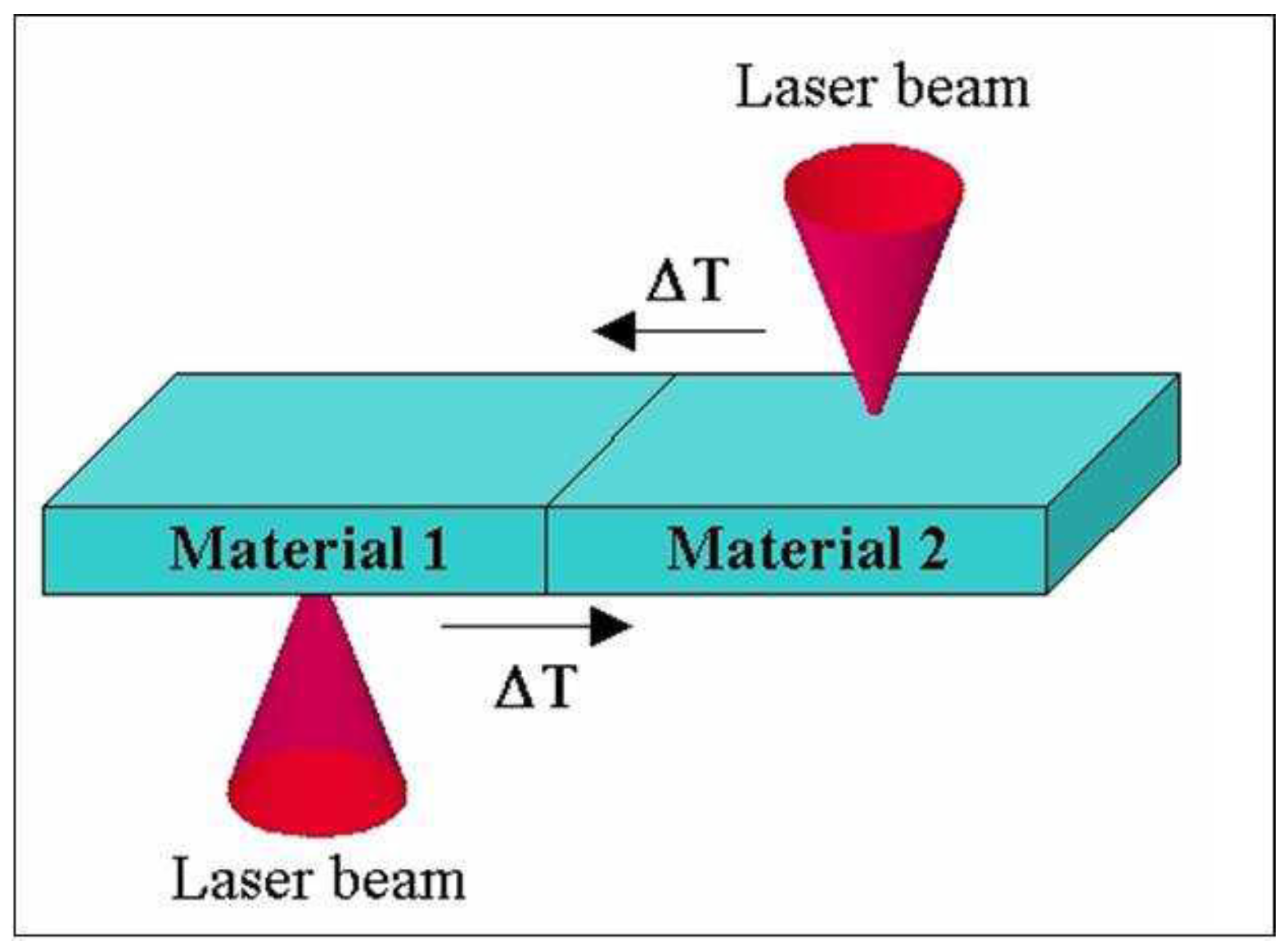
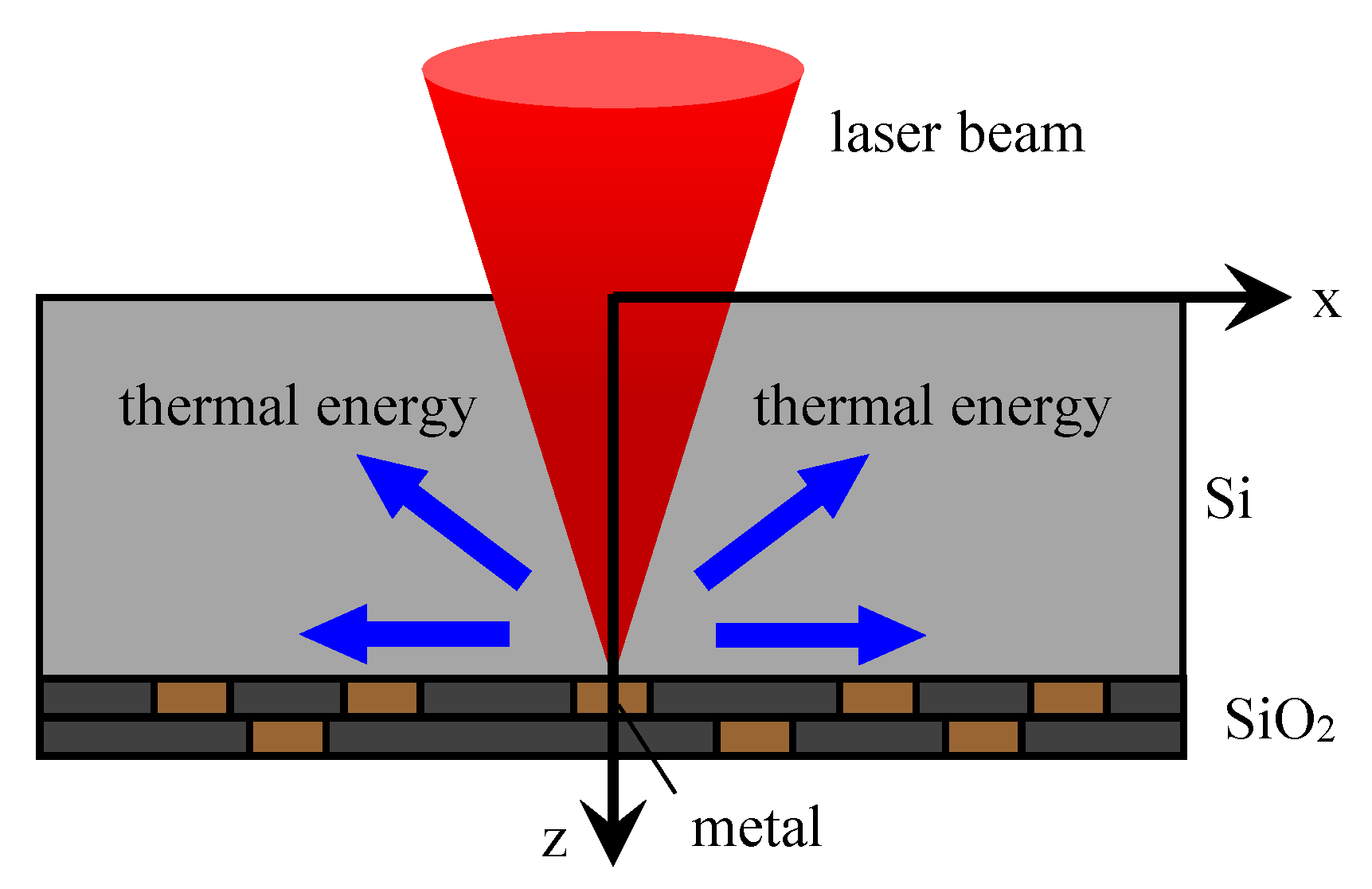

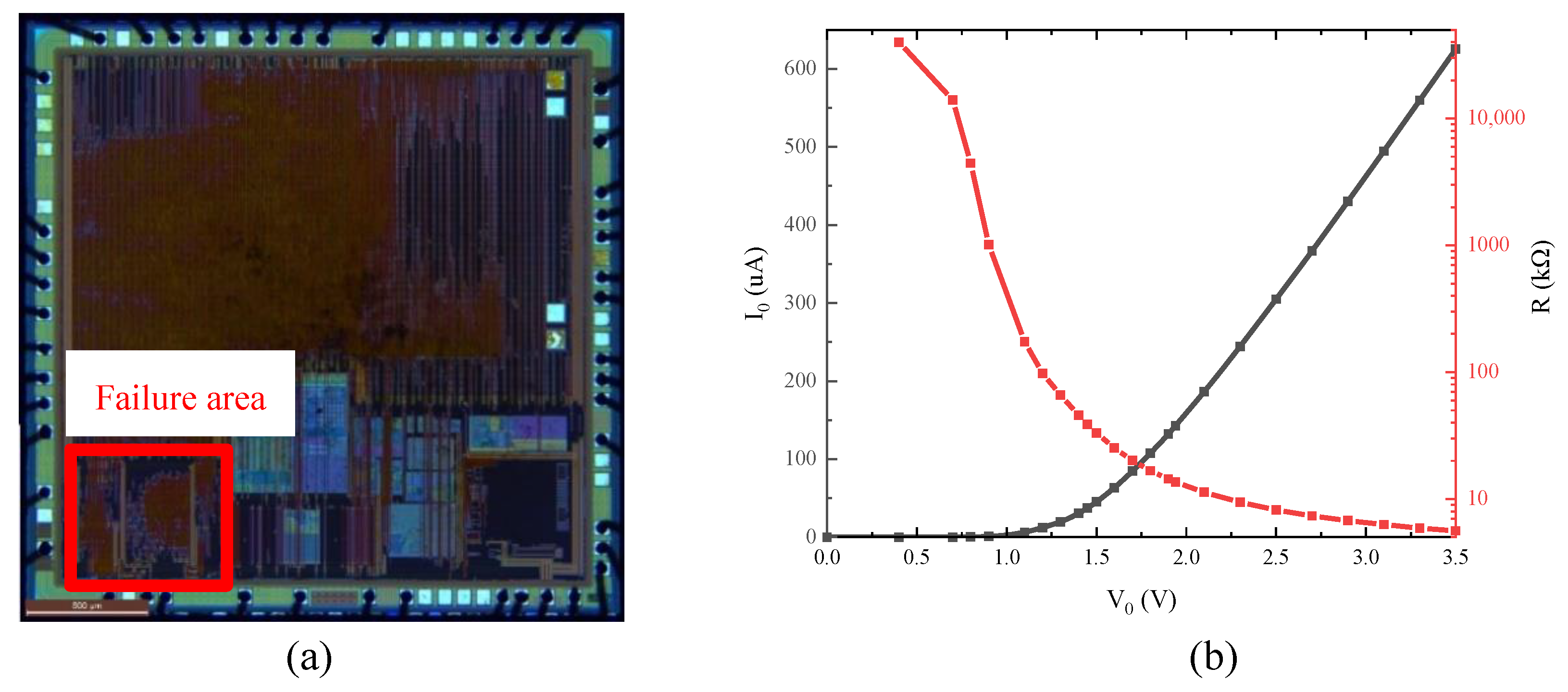

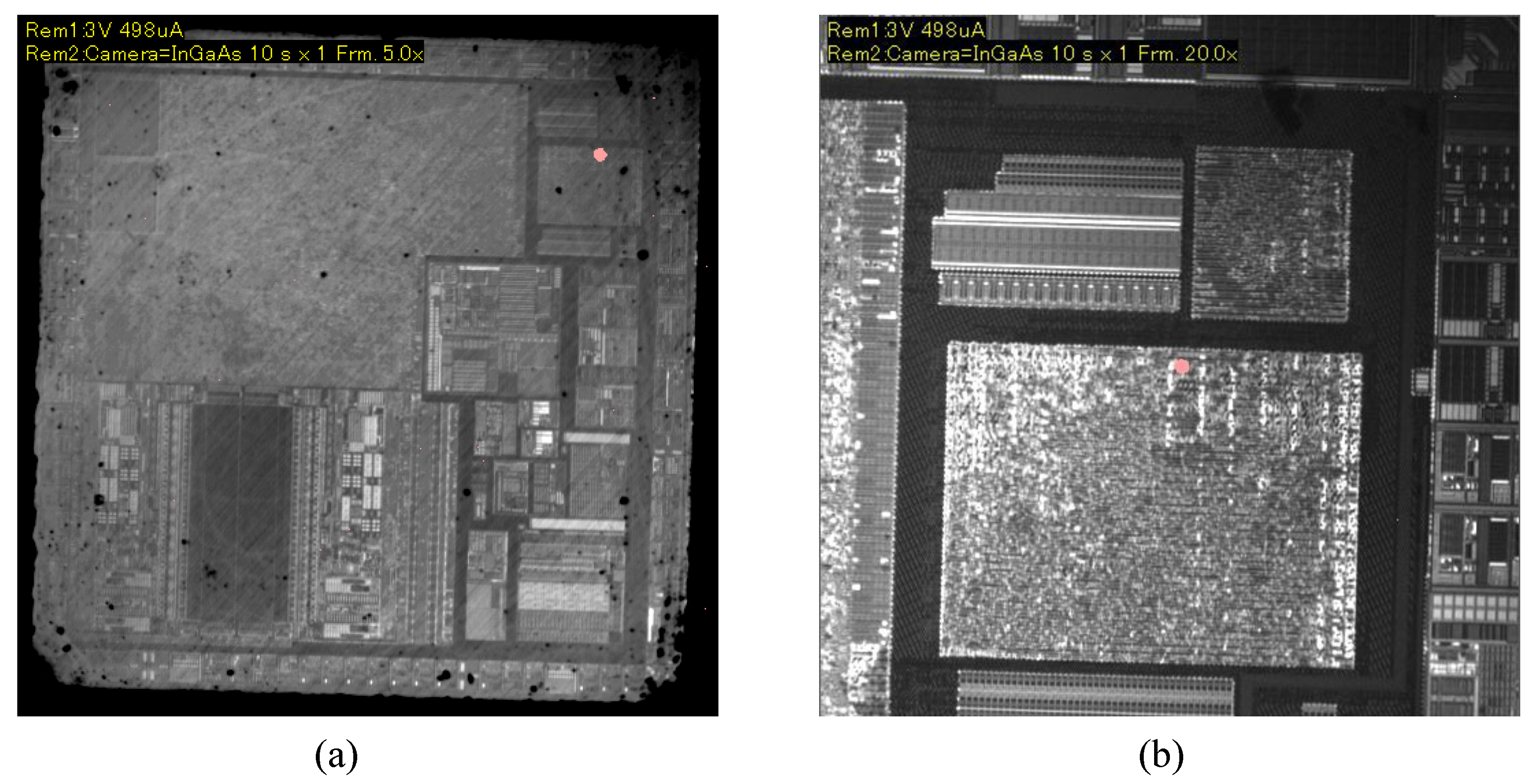
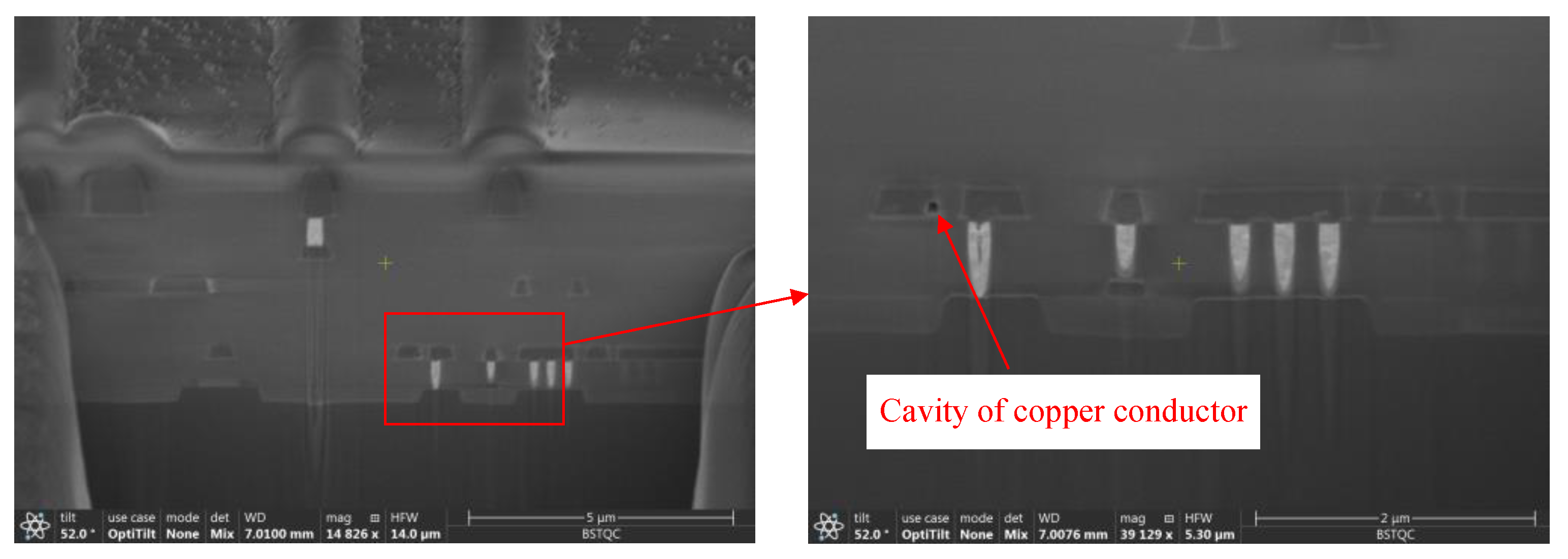
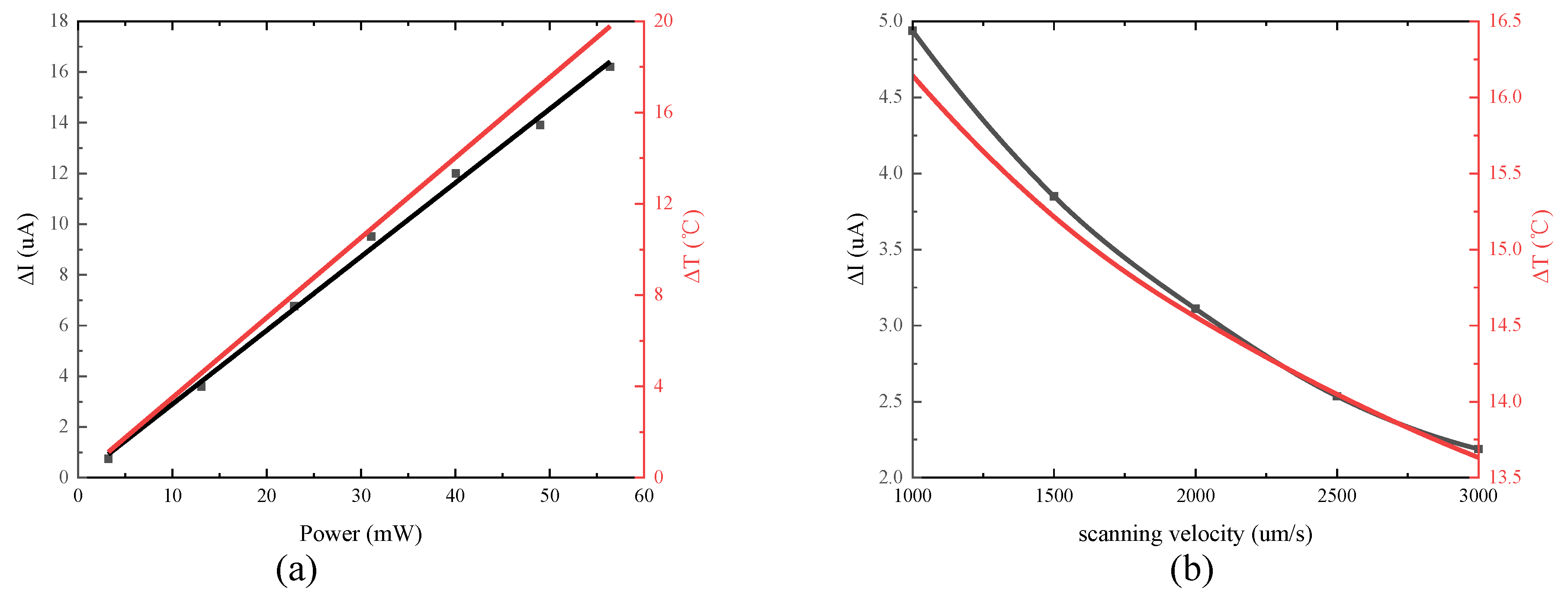



| Material | (20 °C) () | (°C−1) |
|---|---|---|
| Al | ||
| Cu |
| Material or Junction | () |
|---|---|
| Al | −3.5 * |
| W | 3.6 * |
| Al/n + Si | 287 ** |
| Al/p + Si | −202 ** |
| laser | Wavelength | 1310 nm |
| Power | 0∼100 mW | |
| Translation Stage | Scanning Speed | 0∼100 mm/s |
| Positioning Accuracy | 0.1 μm |
| Point A (abnormal spot) | 0.120 | 0.0574 |
| Point B (normal spot) | 0.0148 | 0.00845 |
Publisher’s Note: MDPI stays neutral with regard to jurisdictional claims in published maps and institutional affiliations. |
© 2020 by the authors. Licensee MDPI, Basel, Switzerland. This article is an open access article distributed under the terms and conditions of the Creative Commons Attribution (CC BY) license (http://creativecommons.org/licenses/by/4.0/).
Share and Cite
Yang, H.; Chen, R.; Han, J.; Liang, Y.; Ma, Y.; Wu, H. Preliminary Study on the Model of Thermal Laser Stimulation for Defect Localization in Integrated Circuits. Appl. Sci. 2020, 10, 8576. https://doi.org/10.3390/app10238576
Yang H, Chen R, Han J, Liang Y, Ma Y, Wu H. Preliminary Study on the Model of Thermal Laser Stimulation for Defect Localization in Integrated Circuits. Applied Sciences. 2020; 10(23):8576. https://doi.org/10.3390/app10238576
Chicago/Turabian StyleYang, Han, Rui Chen, Jianwei Han, Yanan Liang, Yingqi Ma, and Hao Wu. 2020. "Preliminary Study on the Model of Thermal Laser Stimulation for Defect Localization in Integrated Circuits" Applied Sciences 10, no. 23: 8576. https://doi.org/10.3390/app10238576
APA StyleYang, H., Chen, R., Han, J., Liang, Y., Ma, Y., & Wu, H. (2020). Preliminary Study on the Model of Thermal Laser Stimulation for Defect Localization in Integrated Circuits. Applied Sciences, 10(23), 8576. https://doi.org/10.3390/app10238576






